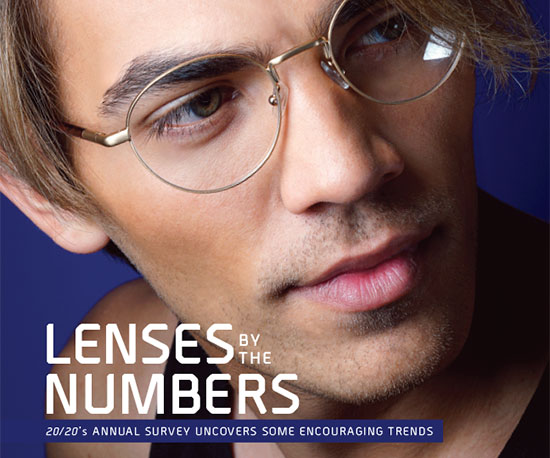
ZAC POSEN Leland from Kenmark; Photographed by Stephen Mark Sullivan
Independent optical retailers are selling an increasingly diverse range of spectacle lenses and treatments, and these products account for a growing portion of their revenue, according to results of 20/20’s newly released Premium Lens MarketPulse Survey.
Compared to three years ago, 65 percent of retailers said that spectacle lenses and treatments made up a larger percentage of their location’s total gross dollar sales in 2015. Fifty-three percent said pricing on spectacle lenses and treatments has increased compared to three years ago as well, and 46 percent said that Rx sun lenses as a percentage of total dollar sales increased over the same period.
Retail prices and presumably profits are also going up. The average price of a lens-only package was $273.47 in 2015, up from $254.71 in 2014 and $248.46 in 2013.
These data points, along with other survey highlights, are featured in the following topline summary. For the complete report, contact senior research analyst Jennifer Waller at [email protected].
—Andrew Karp
LENS SALES
When asked to rank lens design by popularity, standard or aspheric single vision was ranked most popular by 46 percent of retailers. Customized or personalized progressives were ranked most popular by 29 percent, and standard progressives were ranked most popular by 14 percent.
Just under half of retailers (47 percent) said less than 3 percent of single vision Rxs sold are digitally enhanced.
59 percent of retailers said less than 3 percent of single vision digitally-enhanced lenses use actual vertex, tilts and wrap measurements done in the office by the retailer.
Just about two-thirds (65 percent) of retailers said that customized or personalized progressives lenses made up a greater proportion of their total lens sales in 2015 than they had versus three years ago. Comparatively, 36 percent said standard progressive sales had increased over the last three years, while 30 percent said that sales of bifocals and trifocals had decreased as a percentage of total lens sales over the last three years, respectively.
Seventy-nine percent prefer lens manufacturer brands over lab private labels for digital progressive lenses.
COMPUTER/OFFICE LENSES
Most retailers surveyed (48 percent) say that most computer/office lens patients/customers buy by working distance range as opposed to by occupation/vocation or by add power.
LENS MATERIALS
When asked to rank lens material by popularity, polycarbonate was ranked most popular by 49 percent of the retailers. Standard plastic was ranked most popular by 27 percent.
Forty-four percent of retailers said that their 2015 super high-index lens sales increased as a proportion of total lens pair sales compared to one year ago. Fifty-one percent and 48 percent said the same about their polycarbonate lenses and Trivex lenses, respectively.
Sixty-two percent said that their mid-index lens sales had stayed flat. Sales of glass lenses lagged behind; 50 percent of respondents reported that glass made up a smaller proportion of their total lens sales in 2015 than last year.
LENS TREATMENTS
Eighty-two percent of retailers said they offer a new AR lens that also reduced blue light. This is up dramatically from 63 percent last year. They said it has replaced, on average, 20 percent of standard AR.
IMPACT OF REFRACTIVE SURGERY
Forty percent of retailers agreed that because of the increase in patients having refractive surgery, their sales of reading glasses have increased, while 30 percent said specifically high-powered lens sales have decreased. Fifty-six percent, however, said sales have not been affected at all.
PERSONALIZED PROGRESSIVES
Retailers said that 38 percent of their progressive lens sales are personalized, on average.
One-quarter (25 percent) of the progressive lenses with personalized designs include actual vertex, tilt and wrap measurements.
Just under half (46 percent) use the manufacturer’s or lab’s default measurements.
DIGITAL MEASURING DEVICES
Thirty-eight percent of retailers said they have a digital measuring device in their office. Among them, 36 percent said they use it 75 percent to 100 percent of the time. Most (58 percent) are tablet-based.
METHODOLOGY
This sample was derived from the proprietary Jobson Optical Research database. This survey was conducted by Jobson Optical Research’s in-house research staff. Data collection was conducted in February 2016. Only the responses of independent optical retailers are included in the report. The 2016 sample consists of 265 independent optical retailers. All participants were recruited by e-mail, and the questionnaire was completed online. Three years of data is provided for comparisons where possible.
—Jennifer Waller
Jobson Optical Research
Forty-seven percent of retailers said they use package pricing. The average price of a lens-only package was $273.47.
OUTDOOR EYEWEAR
Sixty-two percent said they have increased discussions with their patients on the importance of UV and HEV-absorbing eyewear for outdoor use, and 53 percent have actually written more Rxs for them in the last three years.
Fifty-seven percent said they have increased discussions with their patients on the importance of children’s outdoor eyewear/sunwear, and 39 percent have actually written more Rxs for them in the last three years.■






















